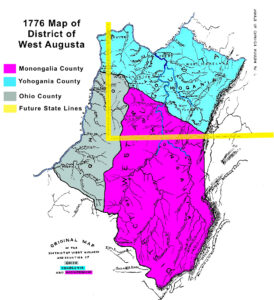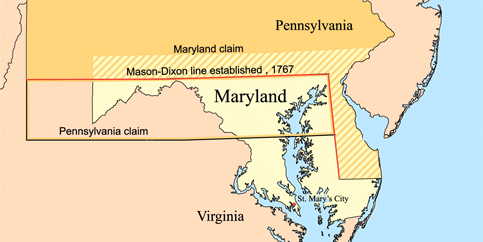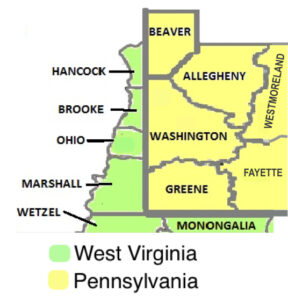How the Northern Panhandle of West Virginia was formed
This post covers how the current West Virginia Northern Panhandle was formed and the history leading up to it. Our Virginia ancestors, Abraham Van Metre and his brother Jacob (sons of John Van Metre the Indian Trader), were instrumental in the fight between Virginia and Pennsylvania over these lands. Timeline changes for the counties are important for Genealogy research. This one becomes complex, due to the conflicting claims by Virginia and Pennsylvania over the same lands.
1749-1760
European fur traders such as Peter Chartier established trading posts in the region in the early eighteenth century.
In 1749, Captain Pierre Joseph Céloron de Blainville claimed the Ohio valley and all of western Pennsylvania for King Louis XV of France. The captain traveled along the Ohio and Allegheny rivers. He installed lead plates in the ground to mark the land for France.
Most of the towns during that era were developed along waterways, which were the primary transportation routes, as well as providing water of domestic uses. Through the eighteenth century, both the french and the British competed for control over the local rivers in this frontier territory of North America. Native American bands and tribes allied with the colonists to differing degrees, often based on their trading relationships. The British send Major George Washington to expel the french from their posts, with no success. he also nearly drowned in the ice-filled Allegheny River while returning to camp.
The English tried again in 1754 to establish a post in the area. They sent 41 Virginians to build Fort Prince George. The French learned of the plan and sent an army to capture the fort. They resumed building it and added increased defensive fortification, renaming it as Fort Duquesne.
Given it’s strategic location at the Ohio, Fort Duquesne became an import focal point of the french and Indian War. The first British attempt to retake the fort failed miserably. In 1758 British forces under General John Forbes recaptured the fort; he had it destroyed to prevent any use by the French. The British built a new, larger fort on the site, including a moat, and name it Fort Pitt. The historic site has been preserved at Pittsburgh’s Point State Park.
Table of Contents
1760-1780
Before the Colony of Virginia and the Province of Pennsylvania agreed to extend the Mason-Dixon line westward from the western boundary line of the Province of Maryland, the area was sparsely populated in the years following the French and Indian War (1754-1763), and neither colony made any serious attempts at forming a local government until the early 1i770s. Virginia administerd the region as a par tof August County, Virginia. Pennsylvania later established Westnoreland County with its seat at Hannastown, overlapping Virginia’s claims.
Virginia’s governor, Lord Dunmore, traveled to Pittsburgh, which Virginia claimed as part of its territory, to appoint government officials under the Virginia charter. In 1774, the Virginia assembly separated the western portion of August County’s territory and formed the District of West Augusta.

A preamble to a later act defined the boundaries of West Augusta as follows:
Whereas, it is expedient to ascertain the boundary between the county of Augusta and the district of West Augusta-Be it therefore enacted by the General Assembly of the Commonwealth of Virginia, that the boundary between the said district and county shall be as follows:
Beginning on the Alleghany Mountains, between the heads of the Potomac, Cheat and Green Briar Rivers (Haystack Knob, or north end of Pocahontas County);
thence along the ridge of mountains which divides the waters of Cheat River from those of Green Briar, and that branch of the Monongahela River called Tyger’s Valley River, to the Monongahela River;
thence up the said river, and the west fork thereof, to Bingerman’s Creek, on the northwest side of the said west fork;
thence up the said creek to the head thereof, thence in a direct course to the head of Middle Island Creek, a branch of the Ohio,
and thence to the Ohio, including all the waters of said creek in the aforesaid District of West Augusta, all that territory lying to the northward of the aforesaid boundary, and to the westward of the States of Pennsylvania and Maryland, shall be deemed, and is hereby declared to be, within the District of West Augusta.
The following several years were contentious. Local official from Virginia arrested their counterparts from Pennsylvania and vice versa. East state made movements to stem the flow of settlers from the other state.
The government of West Augusta was administered from Fort Dunmore in what is now Pittsburgh. The seat of government was later moved to Augusta Town in what is now Washington County, Pennsylvania. In August 1776, Augusta Town became the site of the first court west of the Monongahela River.
In 1776, The District of West Augusta was divided into three counties: Ohio county, Monongalia County, and Yohogania County. Ohio County encompassed most of the western region of the district bordering the Ohio River, including parts of what are now Washington and Greene Counties in Pennsylvania. Monongalia County encompassed much of what is now north-central West Virginia, and parts of whaat are now Washington, Greene and Fayette Counties in Pennsylvania. Yohogania County consisted of much of what is now southwestern Pennsylvania, including all of what is now Westmoreland County, Pennsylvania, parts of the present counties of Washington, Fayette, Allegheny, and beaver and the counties of Hancock County, West Virginia and the northern part of Brooke County, West Virginia.
The Mason-Dixon Line was established in 1767 due to the dispute between Pennsylvania and Maryland over their border. The original Mason-Dixon Line only went west as far as the western border of Maryland.

stopped at the western border of Maryland.2
1780

In 1780, the boundary dispute between Virginia and Pennsylvania was finally settled when both sides agreed to extend the Mason Dixon line westward from Maryland to 80º 31′ west, the current western border of Pennsylvania.
Most of Yohogania County became part of Pennsylvania; that section of its lands was divided between Westmorland County and the newly formed Washington county in Pennsylvania; Beaver and Allegheny were later created from those counties. The relatively small part of Yohogania that remained in Virginia was subsumed into Ohio county,. That area is now divided between Brooke County and Hancock County, Virginia (now West Virginia) which were later formed from Ohio County, at the northernmost tip of West Virginia’s Northern Panhandle.
However, prior to the Mason Dixon Line being extended, although Pennsylvania had prohibited the legal settlement of its southwest corner, this did not halt squatters from taking possession of the land. Virginia on the other hand, was offering land for settlement in the area and also supplied protection for their settlers. In fact, Virginia had been handling the affairs of the area as Augusta County since 1754. In order to have a more official presence in the area, Pennsylvania, in 1773, created Westmoreland County, the same year Virginia established the District of Augusta.
Virginia had issued certificates to those holding land north of the Mason and Dixon Line. This made it possible for those settlers to be eligible for Pennsylvania warrants. If a conflict arose over land ownership, the property was given to the older claim regardless of the state which had issued the claim.
Virginia formally dissolved its overlapping claims with Pennsylvania in 1786, reducing Monongalia and Ohio County and entirely extinguishing Yohogania County.
Timeline of County Changes
For the West Virginia Northern Panhandle and Western Pennsylvania Counties.
West Virginia Panhandle Counties (previously Virginia)
1754 Augusta County
original Virginia County in this area / overlapping with Cumberland County, Pennsylvania. Augusta County became the District of Augusta and broken into three counties in 1776: Ohio County, Monongalia County and Yohagania County.
1776 Ohio County, District of Augusta, Virginia
out of Augusta County.
1776 Monongalia County, District of Augusta, Virginia
out of August County.
1776 Yohagania County, District of Augusta, Virginia
out of Augusta County. County ceased to exist in 1780’s when Mason Dixon line was moved further west and most of the area was absorbed by Pennsylvania and Ohio County, Virginia was reformed.
1797 Brooke County, Virginia
out of Ohio County
1825 Marshall County, Virginia
Out of Ohio County
1848 Hancock County, Virginia
out of Brooke County
1863 West Virginia became a state and Brooke, Marshall, Hancock and Ohio Counties became part of West Virginia.
For Western Pennsylvania Counties
1682 Chester County, Pennsylvania
Original County
1729. Lancaster County, Pennsylvania
out of Chester County – some early court records have been transferred to the Lancaster Historical Society.
1750 Cumberland County, Pennsylvania
out of Lancaster County
1771 Bedford County, Pennsylvania
out of Cumberland County
1773 Westmoreland County, Pennsylvania
out of Bedford County
1781 Washington County, Pennsylvania
out of Westmoreland County
1783 Fayette County, Pennsylvania
out of Westmoreland County
1788. Allegheny County, Pennsylvania
out of Washington and Westmoreland Counties
1796 Greene County, Pennsylvania
out of Washington County
1800 Beaver County, Pennsylvania
out of Allegheny and Washington Counties
Citations & Attributes:
- 1776 Map of District of West August, Virginia – https://commons.wikimedia.org/wiki/File:Map_of_Ohio,_Monongalia,_%26_Yohogania_Counties.jpg#/media/File:Map_of_Ohio,_Monongalia,_&_Yohogania_Counties.jpg
- Mason-Dixon Line-Province of Maryland 1632-1776. By Karl Musser - Karl Musser, CC BY-SA 3.0, https://commons.wikimedia.org/w/index.php?curid=1331400. This file is licensed under the Creative Commons Attribution-Share Alike 3.0 Unported license.
